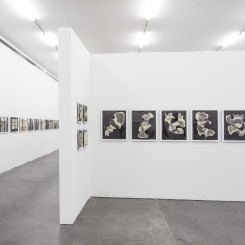“WUZHI: 1985-2008 Geng Jianyi Solo Exhibition”
Minsheng Art Museum (Shigang 1st Road, Changning, Shanghai, China). Sep 08 – Oct 12 2012.
Power Station of Art (Lane 20, Huayuangang Lu, Near Miaojiang Lu, Huangpu district). Oct 1 2012 – Mar 31 2013.
Paul Gladston and Ge Si Di in conversation about the 2012 Shanghai Biennale and Geng Jianyi’s Retrospective at the Minsheng Art Museum, Shanghai
Location: Paul Gladston’s office at the University of Nottingham. Early autumn sunshine plays over motes of dust filling the air near a collection of desiccated houseplants. Gladston wipes distractedly at a teacup stain on his desk. Ge inspects the bookshelves. E-mail chimes accumulate.
Paul Gladston: How was your recent visit to Shanghai? I’m very interested to hear your view of events surrounding this year’s Biennale.
Ge Si Di: Well, there’s clearly vaulting ambition in terms of the Biennale’s relocation to massive venues at the 2010 Expo site as well as the inclusion of international pavilions representing cities around the world. The VIP opening of the Biennale at the new Shanghai Museum of Contemporary Art, which is situated in a decommissioned power station on the Puxi side of the Huangpu river, was certainly spectacular — not just in terms of the scale of the building and the number and range of works on show, but also the now ubiquitous “techno” party at the end of the evening. It’s a brave new world…but, for me, a completely overblown one. I know we are supposed to respect post-colonialist injunctions against seeing non-Western contemporary art initiatives such as this as secondary and belated. However, it did come across, rightly or wrongly, as an attempt to reproduce sublime conditions of display we have become all too familiar with at venues such as Tate Modern and the Venice Biennale.
PG: There are various social engagement and outreach activities attached to the Biennale this time around. Surely, that’s a step forward?
GSD: As you know, I’m skeptical about the now-established tendency towards curatorial social work; for me it sets up all sorts of unexamined ideological contradictions and constraints. It certainly doesn’t square well with the up-market VIP opening party thrown by the Biennale’s organizers. It would be interesting to do some research on the actual impact of social outreach activities attached to art exhibitions such as the Biennale. It’s also reduced the role of the artist to that of a bit player ― that seems controlling and restrictive to me. As far as the Biennale is concerned there’s no critical edge. All of the curatorial statements about “reactivation” and “energy exchange” are just too vague to be critically meaningful. We live in distinctly uncritical times that privilege abstract notions of trans-national interaction and exchange over negation and contretemps. It’s an internationalized revisiting of the worst excesses of the 1960s counter-culture. Added to that, there’s always a deadening effect surrounding big public shows in China. We can’t overlook localized constraints on critical expression within the PRC and the necessary complicity of any public exhibition with governmental authority. In the case of the Shanghai Biennale the nature of the enterprise is just too complicit with authoritarian displays of size and power ― the historical use of sublimity within China to engender feelings of moral supplication to power ― not to mention state-directed real estate value transfer. The Biennale reproduces the form of an international “survey” show in line with examples set in Westernized contexts, but without the possibility of any significant critical or social content. That’s not an outcome confined to China these days. As a result, the work on show is instantaneously recuperated. The Biennale should have attempted to do something distinct both thematically and in terms of its presentation, and therefore far more telling in social/critical terms. But perhaps, given the circumstances, it simply can’t do that.
A momentary silence settles on the room. Ge fingers a copy of Brian Eno’s A Year — with Swollen Appendices. Gladston responds reluctantly to an e-mail about changes to student assessment.
